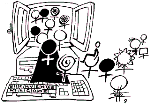Fall 97
Winter 98
Part 2
Part 4
Part 5
Part 6
Part 7
Part 8
Part 9
Part 10
Part 11
SITE MAP
ABOUT US
PAST ISSUES
LETTERS
SUBSCRIBE
COPYRIGHT
The Women’s Internet Conference

The Women’s Internet Conference was held in Ottawa from October 18th to 21st. Women came from across Canada to talk about their online work, learn to make use of the Internet, and to generate ideas about how to ensure women have the option of getting online. There were 26 workshops and 62 contributors, presenting and discussing their ideas and work. Workshops covered areas like women’s health, violence against women, networking women with disabilities, community nets, anti-poverty networking, quality of information online, and Citizens for Local Democracy. We also took the time to prepare recommendations for future ways to work together.
We started with an optional half day of introduction to computers and the Internet, to ensure everyone was up to speed. Colleen Whiteduck and Karen Labreche, offered us an Iroquois welcome and blessed the conference, and we were on our way. We had planned that the conference have 12 computers in a “Communications Room”, each with a telephone line and Internet connection. In the early planning stages we had thought that women could sedately do email and show each other their work. It became a place for non-stop idea exchange, Internet Relay Chat, and the Rev Mattie Peltier’s often repeated due to popular demand “Do Your Own Web Design” - so popular that one session had to be at 7 am.
The evenings included a multicultural dinner and entertainment at the Rainbow Women’s Centre organised by Harriet Amani, and a “Web Weaving”, where Laurie Bryson and Robyn Kalda shared their view of some women’s Web sites, and the results of their survey of the site designers.
Conference recommendations were largely aimed at opening up the Internet for women and making it a welcoming and comfortable place to work together. The first call was that there be a change in social policy, so that government policies and programs address the issues and barriers faced by women trying to get, and stay, online. We emphasized that Internet training should be culturally and gender sensitive, and that we need to develop more women’s resources and content online. This acknowledged the groundbreaking work women are doing online, and called for further experimentation in applying communications technology by and for women. We addressed the language barrier(s) of ensuring the Internet is available equally for Francophones as well as Anglophones, and being able to communicate with each other. Aboriginal women also face language barriers in communicating online with each other, as well as geographical barriers, and have so far had little opportunity to get online.
The Conference was a great opportunity to meet face-to-face many women who have been working together online for months or years, and more who are enthusiastic about Internet opportunities. The excitement throughout centred on the need to strategize together, and the vision we share. The networking will continue as we work together on our strategies and innovations.
| Top |
Part 1 |
Part 2 |
Part 4 |
Part 5 |
Part 6 |
Part 7 |
Part 8 |
Part 9 |
Part 10 |
Part 11 |
Home |